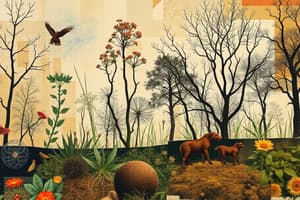Podcast
Questions and Answers
What is the study of how living organisms interact with each other and with their environment?
What is the study of how living organisms interact with each other and with their environment?
- Biome
- Ecology (correct)
- Ecosystem
- Biosphere
Which term refers to the parts of the environment that are alive, or were alive and then died, such as plants, animals, and their remains?
Which term refers to the parts of the environment that are alive, or were alive and then died, such as plants, animals, and their remains?
- Abiotic Factors
- Biotic Factors (correct)
- Biome
- Ecosystem
What is a large community of plants and animals that live in the same place called?
What is a large community of plants and animals that live in the same place called?
- Community
- Ecosystem
- Biome (correct)
- Biosphere
Which term refers to the living things in an area interacting with all of the abiotic parts of the environment?
Which term refers to the living things in an area interacting with all of the abiotic parts of the environment?
What is the term for the parts of the environment that have never been alive, such as sunlight, climate, soil, water and air?
What is the term for the parts of the environment that have never been alive, such as sunlight, climate, soil, water and air?
What is the term for the part of the planet that has living things on it?
What is the term for the part of the planet that has living things on it?
What is the term for all of the populations of different species that live in the same area and interact with one another?
What is the term for all of the populations of different species that live in the same area and interact with one another?
What is the term for the study of how living organisms interact with each other and with their environment?
What is the term for the study of how living organisms interact with each other and with their environment?
Flashcards are hidden until you start studying
Study Notes
Ecology
- The study of how living organisms interact with each other and their environment is called ecology.
- Ecologists examine relationships among organisms, populations, and ecosystems.
Biotic Factors
- Biotic factors refer to parts of the environment that are alive or once lived, including plants, animals, and their remains.
- These factors significantly influence the ecosystem.
Biome
- A large community of plants and animals living in the same place is called a biome.
- Biomes are characterized by specific climate conditions and types of vegetation.
Ecosystem
- An ecosystem consists of living things (biotic components) and non-living parts (abiotic components) interacting in a specific area.
- This includes relationships between organisms and their physical surroundings.
Abiotic Factors
- Abiotic factors encompass the non-living components of the environment, such as sunlight, climate, soil, water, and air.
- These factors shape the conditions of habitats and influence living organisms.
Biosphere
- The biosphere refers to the parts of the planet that support life.
- It includes all ecosystems and biomes where living organisms reside.
Community
- A community is defined as all the populations of different species living in the same area, interacting with one another.
- Communities are integral to studying biodiversity and ecological dynamics.
Additional Note on Ecology
- The term ecology can also refer to the scientific discipline that explores the structure, function, and dynamics of ecosystems.
Studying That Suits You
Use AI to generate personalized quizzes and flashcards to suit your learning preferences.




